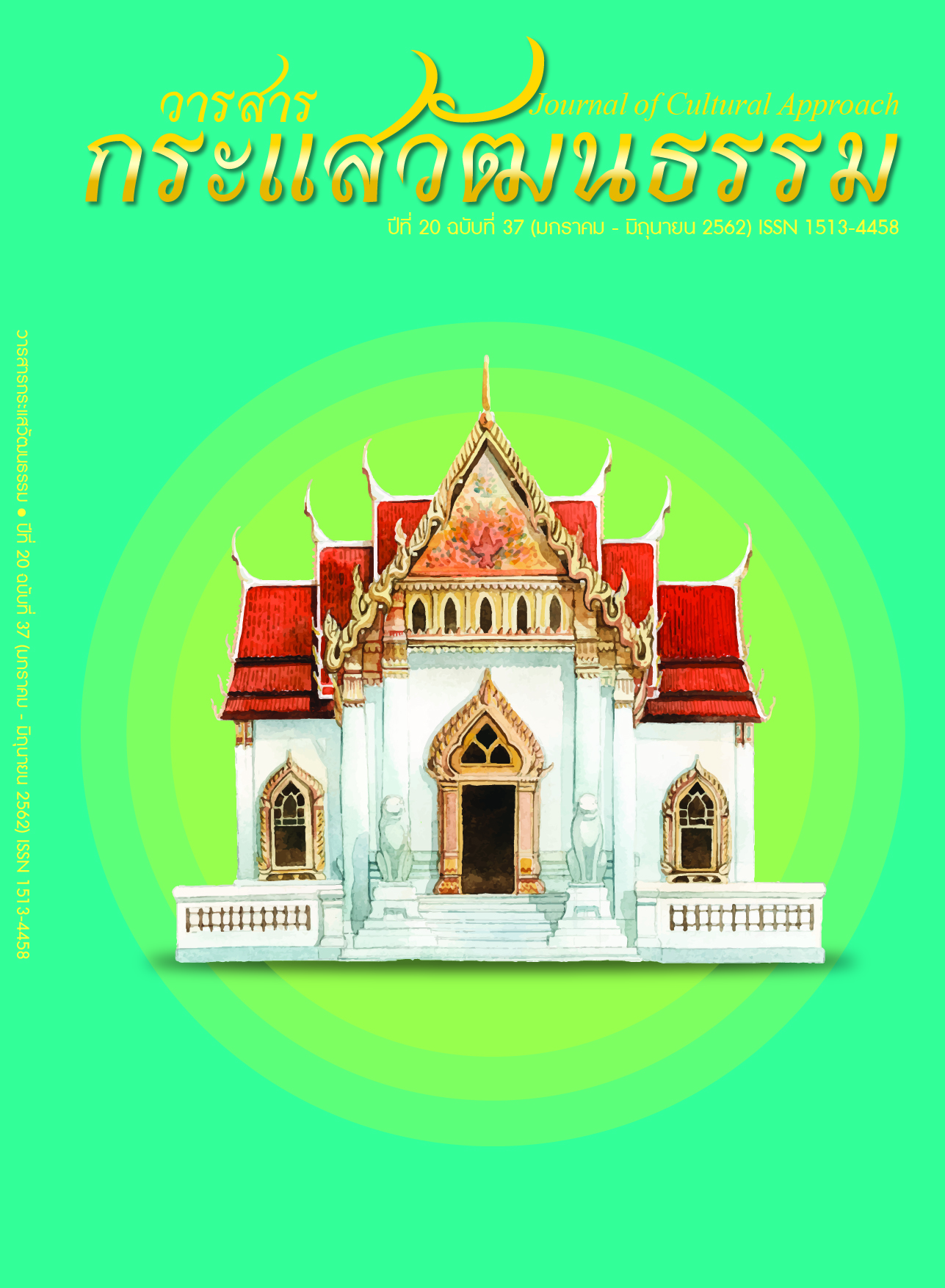การพัฒนารูปแบบการแสดงหมอลำหมู่เชิงธุรกิจ
Main Article Content
บทคัดย่อ
การวิจัยเรื่องการพัฒนารูปแบบการแสดงหมอลำหมู่เชิงธุรกิจ เป็นการวิจัยเชิงคุณภาพ มีวัตถุประสงค์เพื่อการศึกษา 1) เพื่อศึกษาความประวัติความเป็นมาของหมอลำหมู่ 2) เพื่อศึกษาสภาพปัญหาของรูปแบบการแสดงหมอลำหมู่เชิงธุรกิจในปัจจุบัน และ 3) เพื่อศึกษาแนวทางพัฒนารูปแบบการแสดงหมอลำหมู่เชิงธุรกิจ ผู้วิจัยได้เลือกพื้นที่จากคณะหมอลำหมู่ 3 ทำนองคือทำนองขอนแก่น เลือกคณะรัตนศิลป์อินตาไทยราษฎร์ และคณะหนูภารวิเศษศิลป์ ทำนองกาฬสินธุ์ มหาสารคามเลือก คณะศิลปิน การวิจัยเรื่องการพัฒนารูปแบบการแสดงหมอลำหมู่เชิงธุรกิจ เป็นการวิจัยเชิงคุณภาพ มีวัตถุประสงค์เพื่อการศึกษา 1) เพื่อศึกษาความประวัติความเป็นมาของหมอลำหมู่ 2) เพื่อศึกษาสภาพปัญหาของรูปแบบการแสดงหมอลำหมู่เชิงธุรกิจในปัจจุบัน และ 3) เพื่อศึกษาแนวทางพัฒนารูปแบบการแสดงหมอลำหมู่เชิงธุรกิจ ผู้วิจัยได้เลือกพื้นที่จากคณะหมอลำหมู่ 3 ทำนองคือทำนองขอนแก่น เลือกคณะรัตนศิลป์อินตาไทยราษฎร์ และคณะหนูภารวิเศษศิลป์ ทำนองกาฬสินธุ์ มหาสารคามเลือก คณะศิลปินภูไท และคณะเพชรแพรวา ทำนองลำเพลินเลือกคณะสาวน้อยเพชรบ้านแพง และคณะบัวริมบึง เป็นแหล่งในการเก็บรวบรวมข้อมูล นำเสนอผลการวิจัย การวิเคราะห์ข้อมูลตามความมุ่งหมายของการวิจัย โดยการพรรณนาวิเคราะห์
ผลการวิจัยพบว่า 1) ประวัติของเป็นมาของหมอลำหมู่มีประวัติความเป็นมายาวนาน พัฒนามาจากการอ่านหนังสือผูกที่ใช้สำหรับจารวรรณกรรมคำสอนอีสาน และนำมาใส่ทำนองเพื่อให้เกิดความไพเราะ ผลการวิจัยพบว่า 1) ประวัติของเป็นมาของหมอลำหมู่มีประวัติความเป็นมายาวนาน พัฒนามาจากการอ่านหนังสือผูกที่ใช้สำหรับจารวรรณกรรมคำสอนอีสาน และนำมาใส่ทำนองเพื่อให้เกิดความไพเราะ 2) ปัญหาของรูปแบบการแสดงหมอลำหมู่ขาดการจัดการที่เป็นระบบเนื่องจากสมาชิกในวงไม่มีประสบการณ์ และความชำนาญทั้งในการร้องและการลำ การเจ็บป่วยของสมาชิกในวงที่เกิดจากการทำงานต่อเนื่อง หรือความทันสมัยของอุปกรณ์การแสดง รวมไปถึงภัยทางธรรมชาติที่ไม่สามารถคาดการณ์ไว้ล่วงหน้า 3) แนวทางพัฒนารูปแบบการแสดงหมอลำหมู่เชิงธุรกิจ ต้องประยุกต์วัฒนธรรมการแสดงที่มีอยู่เดิมเข้ากับสมัยใหม่มากขึ้นเพื่อสร้างสรรค์สิ่งแปลกใหม่ให้แก่ผู้ชม ปรับเวที ชุดการแสดง อุปกรณ์ประกอบฉากให้เข้ากับเนื้อเรื่องที่แสดงและง่ายต่อการเก็บรักษารวมไปถึงการขนย้ายไปยังสถานที่ต่างๆ วรรณกรรมคำกลอนเน้นการนำวรรณกรรมคำกลอนพื้นบ้านอีสานมาใช้แสดง เรื่องที่นำมาแสดงควรสะท้อนให้เห็นถึงวิถีชีวิตความเป็นอยู่ตามจารีตประเพณีสื่อถึงผู้ชมผู้ฟังเกิดความสมัครสมานสามัคคีในสังคมอีสาน การพัฒนาแบบท่าเต้น หัวใจหลักคือครูผู้สอนเต้นต้องเข้าใจหลักของวัฒนธรรมร่วมสมัยและมีการพลิกแพลงได้อยู่ตลอดเวลาให้เข้ากับสถานการณ์ การบริหารจัดการวง มีการแบ่งหน้าที่ความรับผิดชอบให้ชัดเจน มีการบริหารจัดการรายได้ที่ทันสมัย นำเทคโนโลยีสารสนเทศมาประยุกต์เข้ากับการบริหารรายได้ของวงมีการบันทึกข้อมูลรายรับ รายจ่าย ในแต่ละงาน และที่สำคัญมีการบันทึกการแสดงแล้วเผยแพร่ทางสื่อโซเชียลมีเดียเพื่อสร้างรายได้เพิ่มจากช่องทางดังกล่าว
แนวทางในการพัฒนาดังกล่าวนี้เป็นการแนะนำจากผู้วิจัยที่นำปัญหาที่แต่ละคณะพบเจอนั้นมาหาแนวทางแก้ไขในเบื้องต้น แต่ในทางปฏิบัติแล้วนั้นผู้บริหารหัวหน้าคณะหมอลำคงมีทางออกในการแก้ปัญหาที่ดีอยู่แล้วด้วยความที่มีประสบการณ์ในการทำคณะหมอลำมานาน แนวทางในการพัฒนาดังกล่าวนี้เป็นการแนะนำจากผู้วิจัยที่นำปัญหาที่แต่ละคณะพบเจอนั้นมาหาแนวทางแก้ไขในเบื้องต้น แต่ในทางปฏิบัติแล้วนั้นผู้บริหารหัวหน้าคณะหมอลำคงมีทางออกในการแก้ปัญหาที่ดีอยู่แล้วด้วยความที่มีประสบการณ์ในการทำคณะหมอลำมานาน
Article Details
Proposed Creative Commons Copyright Notices
1. Proposed Policy for Journals That Offer Open Access
Authors who publish with this journal agree to the following terms:
- Authors retain copyright and grant the journal right of first publication with the work simultaneously licensed under a Creative Commons Attribution License that allows others to share the work with an acknowledgement of the work's authorship and initial publication in this journal.
- Authors are able to enter into separate, additional contractual arrangements for the non-exclusive distribution of the journal's published version of the work (e.g., post it to an institutional repository or publish it in a book), with an acknowledgement of its initial publication in this journal.
- Authors are permitted and encouraged to post their work online (e.g., in institutional repositories or on their website) prior to and during the submission process, as it can lead to productive exchanges, as well as earlier and greater citation of published work (See The Effect of Open Access).
Proposed Policy for Journals That Offer Delayed Open Access
Authors who publish with this journal agree to the following terms:
- Authors retain copyright and grant the journal right of first publication, with the work [SPECIFY PERIOD OF TIME] after publication simultaneously licensed under a Creative Commons Attribution License that allows others to share the work with an acknowledgement of the work's authorship and initial publication in this journal.
- Authors are able to enter into separate, additional contractual arrangements for the non-exclusive distribution of the journal's published version of the work (e.g., post it to an institutional repository or publish it in a book), with an acknowledgement of its initial publication in this journal.
- Authors are permitted and encouraged to post their work online (e.g., in institutional repositories or on their website) prior to and during the submission process, as it can lead to productive exchanges, as well as earlier and greater citation of published work (See The Effect of Open Access).
เอกสารอ้างอิง
[2] Nasusin, Surapon. (2007). Development of Lam Ruang Tor Klon Performance in Khon Kaen Styled, Rabeabwatasin Band, Khon Kaen Province. Mahasarakham University.
[3] Sanpradit, Kitisak. (2009). Guidelines for Isan Lam Ruang Tor Klon Performance Potential Development Appropriate to Culture and Economy. Ph. D. Thesis in Cultural Science, Mahasarakham University.
[4] Ubollert, Supawan. (2007). Development Models of Disseminating Isan Folk Arts, Culture, Music and Performance of the Dramatic Art Colleges. Ph. D. Thesis in Cultural Science, Mahasarakham University.
[5] Thammawat, Jaruwan. (1983). Folklore. Bangkok : Aksorn Watthana.
[6] William, P. (1977). Music Culture of the Pacific, the Near East, and Asia. 2nd ed. Englewood, New Jersey: Prentice Hall Inc.


